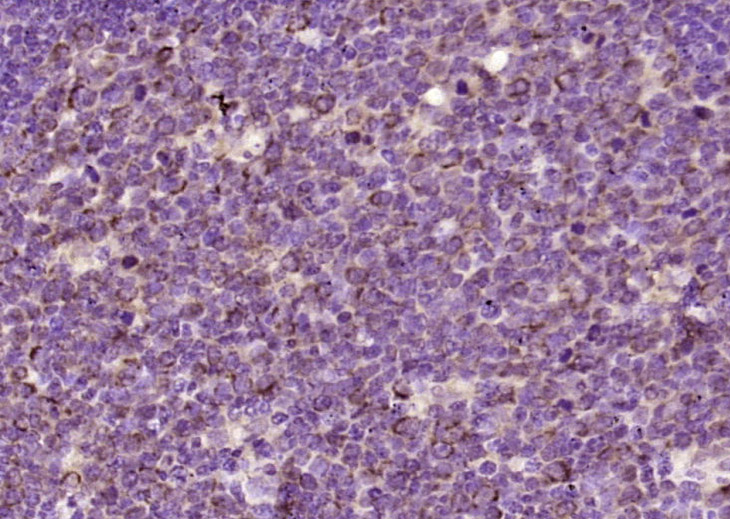
Rabbit Anti-Aurora A+B+C antibody
AIK; ARK1; AURA; AURKA; Aurora 2; Aurora A; Aurora Family Kinase 1; aurora kinase A; Aurora Related Kinase 1; Aurora/IPL1 Like Kinase; Aurora/IPL1 Related Kinase 1; AURORA2; AYK1; BRAK; Breast Tumor Amplified Kinase; BTAK; hARK1; IAK; IPL1 Aurora Related
View History [Clear]
Details
Product Name Aurora A+B+C Chinese Name 有丝分裂激酶A/B/C抗体 Alias AIK; ARK1; AURA; AURKA; Aurora 2; Aurora A; Aurora Family Kinase 1; aurora kinase A; Aurora Related Kinase 1; Aurora/IPL1 Like Kinase; Aurora/IPL1 Related Kinase 1; AURORA2; AYK1; BRAK; Breast Tumor Amplified Kinase; BTAK; hARK1; IAK; IPL1 Aurora Related Kinase 1; IPL1 Related Kinase; MGC34538.
AIK2; AIM1; ARK2; AurB; AURKB; Aurora 1; Aurora and Ipl1 like midbody associated protein 1; Aurora kinase B; Aurora related kinase 2; Aurora-B; Aurora/IPL1 related kinase 2; IPL1; Serine/theronine kinase 12; Serine/threonine protein kinase 12; STK1; STK12; STK5; AURKC; AIE2; AIK3; AurC; AURKC; Aurora C; Aurora/Ipl1 related kinase 3; IPL-1; Aurora/Ipl1/Eg2 protein 2; EC 2.7.11.1; Serine threonine protein kinase 13; STK13; AURKA_HUMAN.Research Area Cell biology Signal transduction Cyclin Kinases and Phosphatases Immunogen Species Rabbit Clonality Polyclonal React Species Human, (predicted: Mouse, Rat, Pig, Cow, Horse, Rabbit, ) Applications WB=1:500-2000 ELISA=1:5000-10000 IHC-P=1:100-500 IHC-F=1:100-500 IF=1:100-500 (Paraffin sections need antigen repair)
not yet tested in other applications.
optimal dilutions/concentrations should be determined by the end user.Theoretical molecular weight 46kDa Cellular localization The nucleus cytoplasmic Form Liquid Concentration 1mg/ml immunogen KLH conjugated synthetic peptide derived from human Aurora A/B/C: 51-150/344 Lsotype IgG Purification affinity purified by Protein A Buffer Solution 0.01M TBS(pH7.4) with 1% BSA, 0.03% Proclin300 and 50% Glycerol. Storage Shipped at 4℃. Store at -20 °C for one year. Avoid repeated freeze/thaw cycles. Attention This product as supplied is intended for research use only, not for use in human, therapeutic or diagnostic applications. PubMed PubMed Product Detail Aurora A plays a role in cell cycle regulation during anaphase and/or telophase, in relation to the function of the centrosome/spindle pole region during chromosome segregation. Aurora A plays a key role during tumor development and progression and is overexpressed in many human cancers including breast, ovarian and colorectal. Aurora A is viewed as a potential target for anticancer drug treatment.
Aurora B is a mitotic protein kinase that phosphorylates histone H3 (probably on Serine 10), behaves as a chromosomal passenger protein, and may regulate several stages of mitosis such as centrosome separation, chromosome segregation and cytokinesis. It localizes to the inner centromere region from prophase to anaphase.
The Aurora kinases, members of the Ser/Thr protein kinase family, associate with microtubules during chromosome movement and segregation. Aurora kinase C may play a part in organizing microtubules in relation to the function of the centrosome/spindle pole during mitosis. This protein is localized to centrosome from anaphase to cytokinesis. Expression is limited to testis in normal cells. Elevated expression levels are seen only in a subset of cancer cells such as HepG2, HuH7 and HeLa cells. Aurora-C expression is maximum at M phase.
Function:
Contributes to the regulation of cell cycle progression. Required for normal mitosis. Associates with the centrosome and the spindle microtubules during mitosis and functions in centrosome maturation, spindle assembly, maintenance of spindle bipolarity, centrosome separation and mitotic checkpoint control. Phosphorylates numerous target proteins, including ARHGEF2, BRCA1, KIF2A, NDEL1, PARD3, PLK1 and BORA. Regulates KIF2A tubulin depolymerase activity (By similarity). Required for normal axon formation. Plays a role in microtubule remodeling during neurite extension. Important for microtubule formation and/or stabilization.
Subunit:
Interacts with FBXL7 (By similarity). Interacts with CPEB1, JTB, TACC1, TPX2, PPP2CA, as well as with the protein phosphatase type 1 (PP1) isoforms PPP1CA, PPP1CB and PPP1CC. Interacts also with its substrates ARHGEF2, BORA, BRCA1, KIF2A, PARD3, and p53/TP53. Interaction with BORA promotes phosphorylation of PLK1. Interacts with PIFO. Interacts with GADD45A, competing with its oligomerization. Interacts (via C-terminus) with AUNIP (via C-terminus). Identified in a complex with AUNIP and NIN. Interacts with FRY; this interaction facilitates AURKA-mediated PLK1 phosphorylation.
Subcellular Location:
Cytoplasm, cytoskeleton, centrosome. Cytoplasm, cytoskeleton, spindle pole. Note=Detected at the neurite hillock in developing neurons (By similarity). Localizes at the centrosome in mitotic cells from early prophase until telophase, but also localizes to the spindle pole MTs from prophase to anaphase. Moves to the midbody during both telophase and cytokinesis. Associates with both the pericentriolar material (PCM) and centrioles.
Tissue Specificity:
Highly expressed in testis and weakly in skeletal muscle, thymus and spleen. Also highly expressed in colon, ovarian, prostate, neuroblastoma, breast and cervical cancer cell lines.
Post-translational modifications:
Activated by phosphorylation at Thr-288; this brings about a change in the conformation of the activation segment. Phosphorylation at Thr-288 varies during the cell cycle and is highest during M phase. Autophosphorylated at Thr-288 upon TPX2 binding. Thr-288 can be phosphorylated by several kinases, including PAK and PKA. Protein phosphatase type 1 (PP1) binds AURKA and inhibits its activity by dephosphorylating Thr-288 during mitosis. Phosphorylation at Ser-342 decreases the kinase activity. PPP2CA controls degradation by dephosphorylating Ser-51 at the end of mitosis.
Ubiquitinated by the E3 ubiquitin-protein ligase complex SCF(FBXL7) during mitosis, leading to its degradation by the proteasome. Ubiquitinated by CHFR, leading to its degradation by the proteasome (By similarity). Ubiquitinated by the anaphase-promoting complex (APC), leading to its degradation by the proteasome.
Similarity:
Belongs to the protein kinase superfamily. Ser/Thr protein kinase family. Aurora subfamily.
Contains 1 protein kinase domain.
SWISS:
O14965
Gene ID:
6790
Database links:Entrez Gene: 6790 Human
Entrez Gene: 20878 Mouse
Omim: 603072 Human
SwissProt: O14965 Human
SwissProt: P97477 Mouse
Unigene: 250822 Human
Unigene: 249363 Mouse
Product Picture
Bought notes(bought amounts latest0)
No one bought this product
User Comment(Total0User Comment Num)
- No comment



 +86 571 56623320
+86 571 56623320
 +86 18668110335
+86 18668110335

